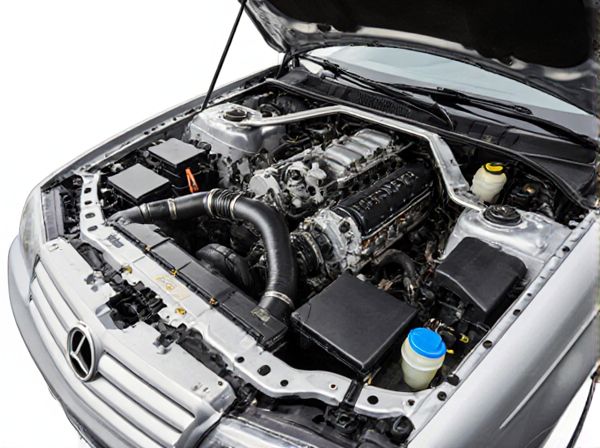
Photo illustration: Flat-Plane Crankshaft vs Cross-Plane Crankshaft
Flat-plane crankshafts offer higher revving capabilities and reduce rotational inertia, making them ideal for performance-focused engines seeking quick throttle response. Cross-plane crankshafts provide smoother operation and better balance by reducing engine vibrations, enhancing comfort during everyday driving. Your choice depends on whether you prioritize sporty performance or refined smoothness in your vehicle.
Table of Comparison
| Feature | Flat-Plane Crankshaft | Cross-Plane Crankshaft |
|---|---|---|
| Design | Crank throws at 180deg angles, flat layout | Crank throws at 90deg angles, cross-shaped layout |
| Engine Type | Common in high-revving V8s, sports cars | Typical in American V8s, muscle and luxury cars |
| Vibration | Higher vibrations, requires balance shafts or engine mounts | Smoother operation, better inherent balance |
| Sound | Sharper, higher-pitched exhaust note | Deeper, throaty exhaust tone |
| Performance | Better high-RPM response, lighter crankshaft | Stronger low-end torque, increased mass |
| Manufacturing Complexity | Simpler, less material used | More complex, heavier and costlier |
| Application | Ferrari, some Honda V8s | Ford, Chevrolet V8 engines |
Introduction to Crankshaft Types
Flat-plane crankshafts feature crankpins positioned 180 degrees apart, enabling a simpler design that enhances engine responsiveness and high-revving capabilities, commonly found in performance-oriented V8 engines. Cross-plane crankshafts have crankpins arranged at 90-degree intervals, which offer smoother power delivery and reduced vibration, typical in American muscle cars and luxury vehicles. Each crankshaft type significantly influences engine character, affecting torque output, exhaust sound, and overall driving experience.
What is a Flat-Plane Crankshaft?
A flat-plane crankshaft features crankpins positioned at 180-degree intervals, offering a simpler, lighter design commonly used in high-performance engines like those in sports cars. This configuration allows for quicker revving and improved throttle response due to reduced rotational inertia. Flat-plane crankshafts also produce a distinctive exhaust sound and enable more efficient exhaust scavenging compared to cross-plane designs.
What is a Cross-Plane Crankshaft?
A cross-plane crankshaft features crankpins arranged at 90-degree intervals, creating a cross shape when viewed from the front, commonly used in V8 engines to reduce vibrations and improve smoothness. Its design balances the engine's secondary forces and enhances exhaust scavenging, resulting in a distinctive sound and smoother power delivery. Compared to a flat-plane crankshaft, the cross-plane offers better torque characteristics and less vibration, making it ideal for high-displacement V8 applications.
Key Design Differences
Flat-plane crankshafts feature a 180-degree firing interval with crank pins aligned in a single plane, resulting in reduced rotational mass and faster engine response. Cross-plane crankshafts have a 90-degree firing interval with crank pins offset at 90 degrees, providing smoother engine operation and better vibration balance. These design distinctions influence engine sound, performance characteristics, and manufacturing complexity.
Performance Characteristics Comparison
Flat-plane crankshafts offer quicker revving capabilities and more immediate throttle response due to their lighter weight and simpler design, making them ideal for high-revving sports cars. Cross-plane crankshafts provide smoother power delivery and better vibration damping, resulting in enhanced torque characteristics and refinement, which benefits muscle cars and luxury vehicles. Performance trade-offs include flat-plane designs excelling in high-RPM power and agility, while cross-plane configurations prioritize low-end torque and engine smoothness.
Sound and Vibration Differences
Flat-plane crankshafts produce a higher-pitched, sharper exhaust note due to their evenly spaced firing intervals, which is favored in high-performance sports cars for its distinctive sound. Cross-plane crankshafts generate a deeper, rumbling exhaust tone with uneven firing pulses that reduce engine vibrations, enhancing smoothness in V8 engines commonly found in muscle and luxury vehicles. Vibration characteristics differ significantly, as flat-plane designs tend to have more primary vibrations requiring balance shafts or engine mounts, while cross-plane configurations naturally balance secondary forces, resulting in smoother engine operation.
Applications in Automotive Engineering
Flat-plane crankshafts are predominantly used in high-performance sports cars and supercars due to their ability to reduce rotational inertia, enabling faster engine revving and improved throttle response. Cross-plane crankshafts are commonly found in V8 engines of muscle cars and luxury vehicles, providing smoother engine operation and reduced vibration through better primary and secondary balance. Automotive engineers choose flat-plane designs for agility and weight savings, while cross-plane configurations prioritize refinement and torque delivery in everyday driving conditions.
Advantages of Flat-Plane Crankshafts
Flat-plane crankshafts offer advantages such as reduced rotational mass and improved engine responsiveness, enabling higher rev limits and quicker acceleration in sports cars. Their simpler design results in lower manufacturing costs and less vibration at high RPMs compared to cross-plane crankshafts. These characteristics make flat-plane crankshafts ideal for performance-oriented engines seeking lightweight and high-revving capabilities.
Benefits of Cross-Plane Crankshafts
Cross-plane crankshafts provide smoother engine operation by reducing vibrations through their 90-degree crankpin arrangement, which balances the firing order more evenly compared to flat-plane designs. They enhance torque delivery at lower RPMs, improving acceleration and drivability in muscle cars and V8 engines. The inherent balance of cross-plane crankshafts also contributes to increased durability and longevity by minimizing stress on engine components.
Choosing the Right Crankshaft for Your Engine
Choosing the right crankshaft is crucial for engine performance, with flat-plane crankshafts offering higher RPM potential and better exhaust scavenging, ideal for sports and high-revving engines. Cross-plane crankshafts provide smoother operation and improved torque at lower RPMs, suited for muscle cars and street vehicles seeking balanced performance. Understanding your engine's application and desired characteristics guides the optimal choice between flat-plane and cross-plane crankshaft designs.
 caratoz.com
caratoz.com